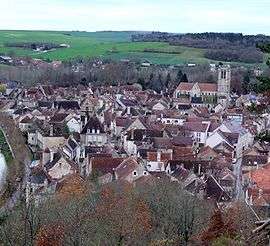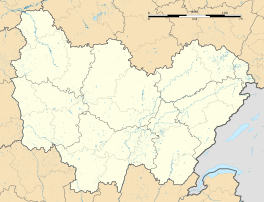Noyers, Yonne
| Noyers | |
|---|---|
 | |
 Noyers | |
|
Location within Bourgogne-Franche-Comté region  Noyers | |
| Coordinates: 47°41′51″N 3°59′41″E / 47.6975°N 3.9947°ECoordinates: 47°41′51″N 3°59′41″E / 47.6975°N 3.9947°E | |
| Country | France |
| Region | Bourgogne-Franche-Comté |
| Department | Yonne |
| Arrondissement | Avallon |
| Canton | Noyers |
| Government | |
| • Mayor (2008–2014) | Marc Domingo |
| Area1 | 35.66 km2 (13.77 sq mi) |
| Population (2006)2 | 744 |
| • Density | 21/km2 (54/sq mi) |
| Time zone | CET (UTC+1) |
| • Summer (DST) | CEST (UTC+2) |
| INSEE/Postal code | 89279 / 89310 |
| Elevation |
167–296 m (548–971 ft) (avg. 189 m or 620 ft) |
|
1 French Land Register data, which excludes lakes, ponds, glaciers > 1 km² (0.386 sq mi or 247 acres) and river estuaries. 2 Population without double counting: residents of multiple communes (e.g., students and military personnel) only counted once. | |
Noyers (French pronunciation: [nwajɛʁ]; often referred to as Noyers-sur-Serein) is a commune in the Yonne department in Bourgogne-Franche-Comté in north-central France.
There are half-timbered houses, ashlars, pillars and pinnacles. There are many cobbled lanes and small squares made of chalky and granitic pavements. There are towers surrounded by the river Serein loops. It has retained much of its medieval appearance with many buildings dating from the 16th century, and is a popular tourist destination with several restaurants, art galleries, a pottery and a museum. The centre is pedestrianised on Saturdays and Sundays in summer. The village also holds two large truffle fairs in November where locally picked fresh truffles are sold to buyers from throughout France and beyond. Residents are known a Nuceriens who are very proud that their village has been officially designated one of the most beautiful in France.
History
The origins of Noyers are unclear. It was founded by the king of Sequani Gaul tribe, just before the Roman conquest, or by a contemporary of Julius Caesar called Lucidorius. He would have given the city its first name, Lucida.
Around and after the 12th century the city became the seat of the Miles family. At the end of the twelfth century, Hugues de Noyers, bishop of Auxerre, built "one of the most famous castles of France". It was beleaguered by Blanche de Castille’s troops in 1217, but it did resist.
In 1419, at the end of the Miles dynasty, Noyers became the property of the dukes of Burgundy. The prince of Condé became count of Noyers. He made a Huguenot place of the city and took refuge in it after the defeat of the Amboise conspiracy in 1568. But Catherine de Médicis dislodged him and the garrison surrendered.
Later the castle was dismantled by King Henry IV in 1599. After a long time of lethargy the city revived in 1710 when the duke of Luynes married the last descendant of the Condé family.
Wine and grain trade were prosperous at Noyers. Many documents attest there were plenty of vines, walnut-trees and cherry-trees over the hills all around Noyers. Till the beginning of the twentieth century a great part of local craftsmen was represented by cartwrights, harness-makers, coopers, farriers and shoe makers. In 1861 there were 128 vine-growers and 25 tillage-farmers. Today they are not so many but farmers are still keeping their places.
Duran Duran sang "New Moon On Monday" in this town in 1983 and its historic streets have been used in several other films and TV series.
Twin towns
-
 Noceto, Italy
Noceto, Italy
See also
References
External links
| Wikimedia Commons has media related to Noyers-sur-Serein. |